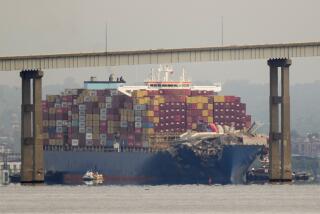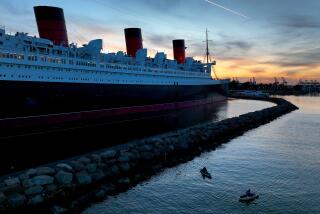Historic U.S. naval vessels to get renewal
- Share via
Reporting from Sparrows Point, Md. — Out of the water for the first time since 1998, the 1854 sloop of war Constellation looked pretty good to its caretakers as they walked beneath its grimy hull, now propped up in dry dock at the Sparrows Point Shipyard.
“I think we’re surprised she’s as clean as she is, for being in the water for 13 years,” said Chris Rowsom, executive director for Historic Ships in Baltimore. “It shouldn’t be too difficult to get her washed up and painted.”
High on blocks just aft of Constellation is the 1944 submarine Torsk, which faces much more extensive work. Repairs to the two ships — key tourist attractions in Baltimore’s Inner Harbor — will cost $500,000.
Rowsom believes it is the first time in Navy history that warships from World War II and the Civil War have been dry-docked together.
The naval relics, put in dry dock last month for a month of repairs, occupy only a slice of the vast facility just outside Baltimore. Constellation is 250 feet long. Torsk is 318 feet long.
With a cold wind blowing, crying gulls wheeled overhead and landed to pick through the dead fish and other morsels on the muddy floor.
“Both boats are pretty much as we thought they would be, which is good,” Rowsom said recently. But “Torsk needs more TLC than Constellation does.”
Paul G. Powichroski, marine superintendent on the project, ticked off some of the Torsk’s problems.
“There are some holes at the waterline,” he said. “The shutter doors [on the forward torpedo tubes] have to be removed.”
Portions of the hull will have steel “doubler” plates attached to cover deteriorating original steel. And the sub will have to be fitted with a cathodic protection system, an electrical system designed to slow corrosion.
By comparison, Powichroski said, “Constellation will get a shave and a haircut.”
It was an apt metaphor. The old warship was covered below the waterline with a 13-year growth of tiny mussels and barnacles.
As impressive as the marine life was for a dirty harbor, it was far less than the 2-inch blanket of shellfish found the last time Constellation was hauled out. Powichroski credited the high-grade anti-fouling paint applied in 1998.
But all of it, along with plenty of harbor grime, will have to be blasted away. Caulking will be checked, and copper seals placed over leaking seams between the butt ends of hull planks. Then the hull will be repainted with a new anti-fouling coat, most of it donated by International Paint.
The 1,400-ton Constellation was built at the Gosport Navy Yard in Portsmouth, Va., in 1854 to replace the 1797 frigate Constellation built in Baltimore. It patrolled the Mediterranean before being sent to West African waters in 1859 as flagship for America’s African Squadron. The squadron chased down and seized slave ships and put their human cargo ashore in Liberia.
During the Civil War, the Constellation saw duty in the Mediterranean and Gulf of Mexico. The vessel has been a fixture in Baltimore’s harbor since 1955, but confusion about its identity and related fundraising difficulties led to years of neglect and deterioration.
By 1993, Navy inspectors warned that without urgent restoration, it might sink at the dock. That led to a $9-million reconstruction of the hull and restoration to the sloop’s Civil War appearance.
The Torsk was built at the Portsmouth Naval Shipyard in New Hampshire and launched in 1944. It arrived in the Pacific in March 1945 and sank three Japanese ships, the last just a day before the war ended.
After the war, the sub served in the Atlantic and the Mediterranean and took part in the 1962 naval blockade of Cuba. Decommissioned in 1968, the Torsk has been berthed in Baltimore since 1973.
More to Read
Sign up for Essential California
The most important California stories and recommendations in your inbox every morning.
You may occasionally receive promotional content from the Los Angeles Times.










